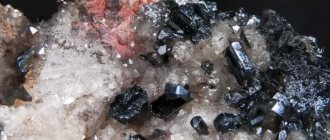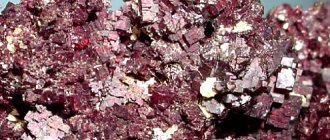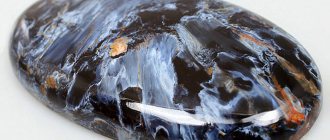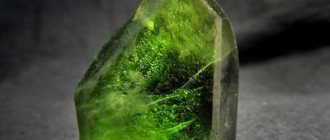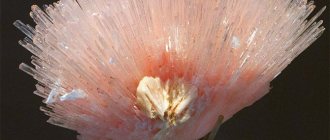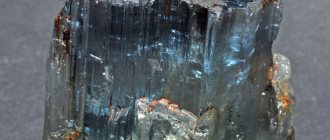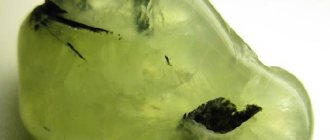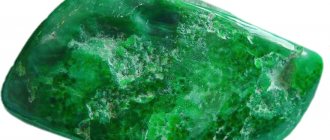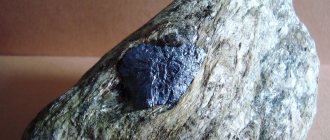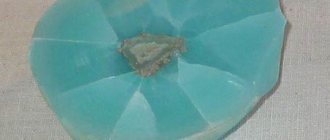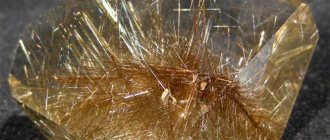Chlorites are a whole family of minerals that are quite widespread in natural conditions. The color of these stones varies from light yellow to dark green, more like black, depending on the variety, of which there are more than twenty. They have a glass or pearlescent luster and, thanks to many other undeniable advantages, are successfully used in various fields.
Chlorite deposits
The formation of the mineral chlorite occurs during hydrothermal processes at low temperatures, often during the transformation of rock containing aluminium-magnesium and ferruginous silicates.
Large deposits are characteristic of metamorphic rocks and quartz veins. In iron ore of sedimentary origin, chlorites form silicate iron ore in the absence of oxygen and the presence of iron compounds. — Advertising —
The territories of Russia (Karelia, the Caucasus, Siberia, the Urals, Transbaikalia, the Far East), Ukraine, Kazakhstan, Georgia, Kyrgyzstan, Tajikistan, and Uzbekistan are rich in chlorite deposits.
History of chlorite
Chlorites, as very common minerals, have been known to man for a long time.
They were used as a source of iron ore, in the production of paint, and individual varieties, as well as intergrowths with other minerals, have recently attracted the attention of collectors and jewelers. The name of the stone is of Greek origin, “chloros” is translated as “green”, this is due to the fact that many varieties of this mineral are characterized by a bottle-green color.
Unusual facts
There are several peculiar facts relating to chlorite. For example, it acts as the most important material for the formation of the greenschist rock formed during chlorite transformations. These minerals are often mined together with serpentine and talc.
Also, chlorites are often located near quartz ore veins, and therefore in nature quite often one can find an intergrowth of quartz and the named mineral.
The mineral belongs to the category of fairly inexpensive stones; souvenirs made from it can be purchased for no more than $10. Things that include combinations of chlorite with other stones have a higher price. If we talk about jewelry, then their cost is determined by the material from which the frame is made.
Sources
- https://kamneteka.com/kamen-hlorit-svoystva/
- https://UvelirnoeDelo.ru/mineral-hlorit/
- https://vamkamen.ru/svoystva-kamney/hlorityi.html
- https://natural-museum.ru/mineral/%D1%85%D0%BB%D0%BE%D1%80%D0%B8%D1%82
- https://jgems.ru/podelochnye/hlorit
- https://zakamnem.ru/vidy/hlorit-mineral
- https://orif64.ru/oberegi/kvarc-s-hloritom-magicheskie-svojstva-2.html
- https://natrukodel.ru/prochie/hlorit
Physicochemical characteristics of chlorite
In its structure, chlorite is a layered silicate that is very similar to mica, namely, an aluminosilicate consisting of magnesium, aluminum, iron, nickel and chromium.
Its crystals have a monoclinic system, mica-like perfect cleavage, translucency (transparent in thin plates), a rich, pearlescent luster, low hardness and specific gravity: hardness on the Mohs scale 2-2.5, specific gravity 2.6-3.02 g/ cm3. — Advertising —
Crystalline chlorite is interesting because it easily splits off thin leaves that are flexible, but not elastic. The mineral is colored brown-green and is often found in the form of granular, leafy masses.
Features of the crystal structure
If we compare the crystal structure of mica with the structure of chlorites, we will see that the layered packets of composition (Mg,Al)3[Si3AlO10][OH]2 common to the minerals under consideration in micas are interlayered with sheets of strong cations of monovalent alkali or divalent alkaline earth metals, while in chlorites, their places are occupied by “brucite” layers, which instead of Mg3[OH]6 have the composition Mg2Al[OH]6 with a residual positive charge equal to unity (similar to K1+ in micas). These layers are loosely connected to the above and underlying layered packages. However, these bonds are still stronger than in the minerals of the talc and kaolinite group, as can be seen from their relatively more difficult decomposition compared to these minerals, as well as from their greater hardness.
Main forms: Morphologically, chlorites are similar to micas. They crystallize in a prismatic c. With. and have various polymorphic modifications; parameters vary within the following limits: a0 = 5.2 - 5.4 A, b0 = 9.2 - 9.36 A, c0 = 28.30 -28.58 A, β = 97° (for chamosite 90°) , Z = 4.
Types of chlorite
The chlorite group includes about twenty varieties of minerals, and the most famous and widespread of them are the following:
- Pennines - deposits of this subspecies are located between Italy and Switzerland, in the so-called Pennine Alps. The mineral consists of aluminosilicates and oxides of magnesium and iron. In terms of appearance, those samples of pennine that contain chromium are interesting. They are characterized by pink, carmine-red and red-violet coloring on chips. The first samples of this chromium-containing variety were discovered in the Urals by mineralogist Alexander Kemmerer, after whom it is sometimes called pennine-kemmererite. This stone is very popular among collectors.
- Clinochlores, also known as seraphinites, are similar in composition to pennines, but it is impossible to confuse these stones, since clinochlore is colored green. Stones are mined in Russia in the Urals. Clinochlore intergrowths are distinguished by a beautiful and unusual internal structure, especially in the case of a chaotic arrangement of crystals. The color palette of the mineral contains all shades of green from light olive to bright grass color, as well as white and pinkish-gray. Clinochlor has a pearlescent luster. Thanks to these properties, interior decorations and jewelry with clinochlores are very popular.
- Thuringites - outwardly resemble graphites or jades, but differ from them in color. The color palette of the mineral varies from light green to black-green. In addition, there are also specimens of pinkish-yellow, gray, brown color with a pearlescent sheen. Thuringite is popular as an ornamental material.
- Chamosite is an iron ore of sedimentary origin, previously widely used for industrial purposes.
Who is it suitable for?
The big advantage of the mineral is that it can be worn by representatives of all zodiac signs. But it will act differently on each of them:
- Aries will become more self-confident and begin to develop their leadership abilities;
- Taurus will be able to protect themselves from people who have a bad influence on them;
- Gemini will find love and build harmonious relationships;
- Cancers will attract good luck;
- Leos will be successful in business and finance;
- Virgos will be able to achieve their goal without being distracted by difficulties;
- Libra will be able to reduce their emotionality and become calmer;
- Scorpios will unleash their creative potential;
- Sagittarius will learn to make the right decisions;
- Capricorns will protect themselves from conflicts with others;
- Aquarians will achieve harmony with their inner world;
- Pisces will increase their attractiveness in the eyes of the opposite sex.
Magical properties of chlorite
Chlorite is considered a powerful cleansing stone; it helps cleanse a person’s aura, neutralize negative emotions, eliminate aggression and fear.
For magical purposes, this mineral is often used in combination with quartz; the so-called “phantom” crystals look like mirror-transparent rock crystal with small green inclusions. This variety takes a very long time to form and may also contain inclusions of other minerals.
Quartz with chlorite absorbs negative energy well, effectively cleanses the internal space, and helps cope with stress. It promotes self-realization of its owner and removes foreign energy from him. It is also an excellent cleanser for the environment.
In combination with other minerals, the magical activity of chlorite increases. For example, together with carnelians, amethysts and rubies, it is able to protect a person from psychological influences, protect from the evil eye and damage, and, as it were, surround him with a powerful protective shield from all negative influences.
Price
In Russian stores you can buy jewelry and esoteric items, collectibles.
Most prices are available (RUB):
- andradite with chlorite (30-50 mm) – 380-720;
- ring (silver) – 14,700;
- pendant (silver, Russia) – 16,300-28,400;
- beads (diameter 11-12 mm) – 3,690.
The cost is increased by a frame made of precious metal.
Green chlorite
Medicinal properties of chlorite
The mineral chlorite improves blood circulation, helps normalize weight, and cleanses the body of toxins. It also increases the level of absorption by the body of vitamins A and E, microelements, stimulates the growth and development of intestinal microflora. With the help of chlorite, they relieve pain of various origins, and also relieve allergic reactions.
Recommendations
- Greenlee E. (1902). "Origins and associations of jaspers in south-east Anglesey". Quarterly Journal of the Geological Society
.
58
(1–4): 425–440. Doi:10.1144/GSL.JGS.1902.058.01-04.29. - Hogan MC (2008). Burnham A (ed.). "Ring of rock carving". Megalithic portal
. - "Serafinite: Mineral Information, Data and Location". www.mindat.org
. Retrieved March 22, 2022.
- Hurlbut CS, Klein C (1985). Manual of Mineralogy
(20th ed.). New York: Wiley & Sons. ISBN 0471805807. - Grove TL, Chatterjee N, Parman SW et al (2006). "The influence of H2 on the melting of the mantle wedge." Planet Earth. Sci. Lett. 249
(1–2): 74–89. Bibcode:2006E and PSL.249...74G. doi:10.1016/j.epsl.2006.06.043. - "Mineral chlorite". Amethyst Galleries
. 1996. Archived from the original on November 25, 2004. Retrieved March 22, 2022. - "Chlorite Group: Mineral Information, Data and Location". mindat.org
. Retrieved March 22, 2022. - "Chlorite". Maricopa.edu
. Archived from the original on November 12, 2004. Retrieved March 22, 2019.]
Industries using chlorite
Previously, large accumulations of ferruginous chlorite (chamosite, thuringite) were used as iron ore. In addition, the transformation products of chlorites were often used as paint. Today, beautiful specimens of this mineral are interesting as collection stones. Among the varieties of chlorite, clinochlore is mainly popular in jewelry.
Physical research methods
Differential thermal analysis
The main lines on the radiographs: Diabantite 15.0(10) - 7.15(9) - 4.62(6) - 3.58(7) - 2.47(6) - 1.545(7) Pennine 14.3( 6) - 7.17(10) - 4.78(10) - 3.585(10) - 2.867(6) - 1.579(4) Kemmererite 15.0(10) - 7.1(10) - 4.7( 10) - 3.59(10) - 2.51(7) - 1.546(9) Clinochlorite 3.53(10) - 1.998(9) - 1.564(9) - 1.535(10) - 1.393(10) - 1.220 (8) Daphnite 6.76(9) - 3.47(5) - 2.55(4) - 2.38(4) - 2.00(5) - 1.55(7) Rishzdolite 7.05( 8) - 4.68(6) - 3.536(7) - 2.589(10) - 2.013(7) - 1.556(10) Sheridanite 7.04(8) - 4.68(9) - 3.509(10) - 1.562 (10) — 1.534(10) — 1.390(10) Corundophilite 7.03(10) — 4.68(9) — 3.51(10) — 2.59(5) — 2.54(5) — 2 .00(5) Pseudothuringite 6.7(8) - 4.69(5) - 3.505(10) - 1.553(6) - 1.539(4) - 1.518(4) Chamosite 7.04(10) - 3.513(10 ) — 2.796(9) — 2.514(9) — 2.137(6) — 1.551(7) Thuringite 6.8(10) — 3.48(10) — 2.59(9) — 2.26(7) — 2.00(9) - 1.552(10)
Ancient methods. Under the blowpipe
Chlorite colors
Despite the fact that the name itself indicates the green color of chlorite, not all of its varieties are colored exactly in shades of green. The color of the mineral is significantly influenced by metal impurities in its composition. Chlorite specimens can be colorless, yellowish, pink, purple, and even almost black.
Classification
Chlorites are a large family of mica-like minerals with a complex chemical composition, which is why their varieties are determined. These include:
- pennine;
- talc – chlorite;
- corundophilite;
- clinochlor;
- pseudothuringitis;
- delessit;
- chamosite;
- brunswigite;
- thuringite;
- kochubeite – clinochlore;
- Nickel chlorite;
- kemmererite - pennine;
- kukeit;
- pennantite;
- gonerite;
- manandonite;
- grohauite;
- kakleichtenbergite;
- afrosiderite;
- grengesite;
- bavalit;
- nibble;
- chamosite.
How to care for chlorite
As a soft and fragile mineral, chlorite requires careful handling and care. Products made from it are protected from impacts and mechanical damage, jewelry is stored separately from other stones. To clean chlorite, use cool running water and a soft cloth; it is better to dry the stone in the air, but in the shade.
